The National Women’s Soccer League (NWSL) has reached a pivotal moment as it prepares to expand its roster of franchises, with targeted growth expected to reshape the landscape of women’s professional soccer in the United States. As commissioner Jessica Berman outlines future initiatives to increase the league’s footprint, a series of critical strategies and potential hurdles come into focus, promising to influence the NWSL’s trajectory in the coming years.
Berman recently made headlines when she indicated that the NWSL’s expansion efforts are not merely a finished chapter but rather a dynamic process that is actively unfolding. Anticipation is building as the league prepares to announce its 16th franchise, speculated to be based in Denver. This franchise will join the already announced BOS Nation FC, marking the completion of two new teams slated for introduction by 2026.
The surge toward expansion signifies a renewed commitment to enhancing the visibility and reach of women’s soccer at both national and local levels. Berman affirmed her enthusiasm about ongoing discussions regarding further expansion, explicitly acknowledging the interest shown by multiple bidders not awarded teams in this latest round. This feedback hints at an expansive landscape of opportunities awaiting the NWSL, signifying the league’s appeal to potential franchise owners and investors.
A critical element of Berman’s approach is grounded in a strategic framework that will guide where the league looks to establish new franchises. She introduced a triad of criteria that are paramount in evaluating potential markets: ownership stability, infrastructure capabilities, and the local market dynamics.
Firstly, the health of ownership is vital. The NWSL’s future teams must be backed by owners who not only possess the financial means to sustain the franchise but also a clear, visionary agenda that empowers the league. Following ownership, infrastructure plays a crucial role. The league demands well-equipped stadiums and training facilities that not only meet existing requirements but also anticipate future growth and technological innovations in sports venues.
Finally, the considerations surrounding market viability recognize the geography of the United States as a catalyst for growth opportunities, indicating that an expansive roster could cultivate competitive sustainability throughout various cities. Berman’s insights concerning the expansive potential suggest that, beyond the immediate markets being discussed, numerous cities could support a successful team, expanding the sport’s reach into previously untapped areas.
As the NWSL gears up for organizational changes, including the discontinuation of the college draft and the introduction of free agency, the league faces a transitional period that could test its structural integrity. Players accustomed to a conventional system will now navigate a landscape that requires adaptability and resilience. This shift represents more than just a rule change; it necessitates a cultural evolution within the league, a fact acknowledged by Berman as a challenging but vital aspect of growth.
The recent new collective bargaining agreement adds additional complexity, as the NWSL and the Players Association collectively absorb the ramifications of these structural modifications. For many players, the uncertainty of employment post-contract becomes a pressing concern, highlighting the need for careful navigation in the new ecosystem.
There is genuine apprehension about the transition as both management and players adjust to these developments. The move away from a traditional draft system brings a learning curve, leaving teams and athletes scrambling to adapt. Berman’s observations about the uniqueness of this situation underscore the necessity for a unified approach that fosters understanding and collaboration among stakeholders in the league.
As the NWSL prepares to embark on this multifaceted journey toward expansion and institutional growth, the enthusiasm is palpable. With the recent announcement of the full schedule for the 2025 season, including a themed Rivalry Weekend and a much-anticipated Decision Day, it is evident that the league is committed to creating memorable and engaging experiences for its fans. As challenges arise, from navigating free agency to establishing new franchises, the NWSL is poised to leverage these opportunities as it continues to elevate women’s professional soccer into the national consciousness. The road ahead is not without its obstacles, but with strategic planning and stakeholder collaboration, the NWSL looks to be well positioned for a successful future.


Leave a Reply